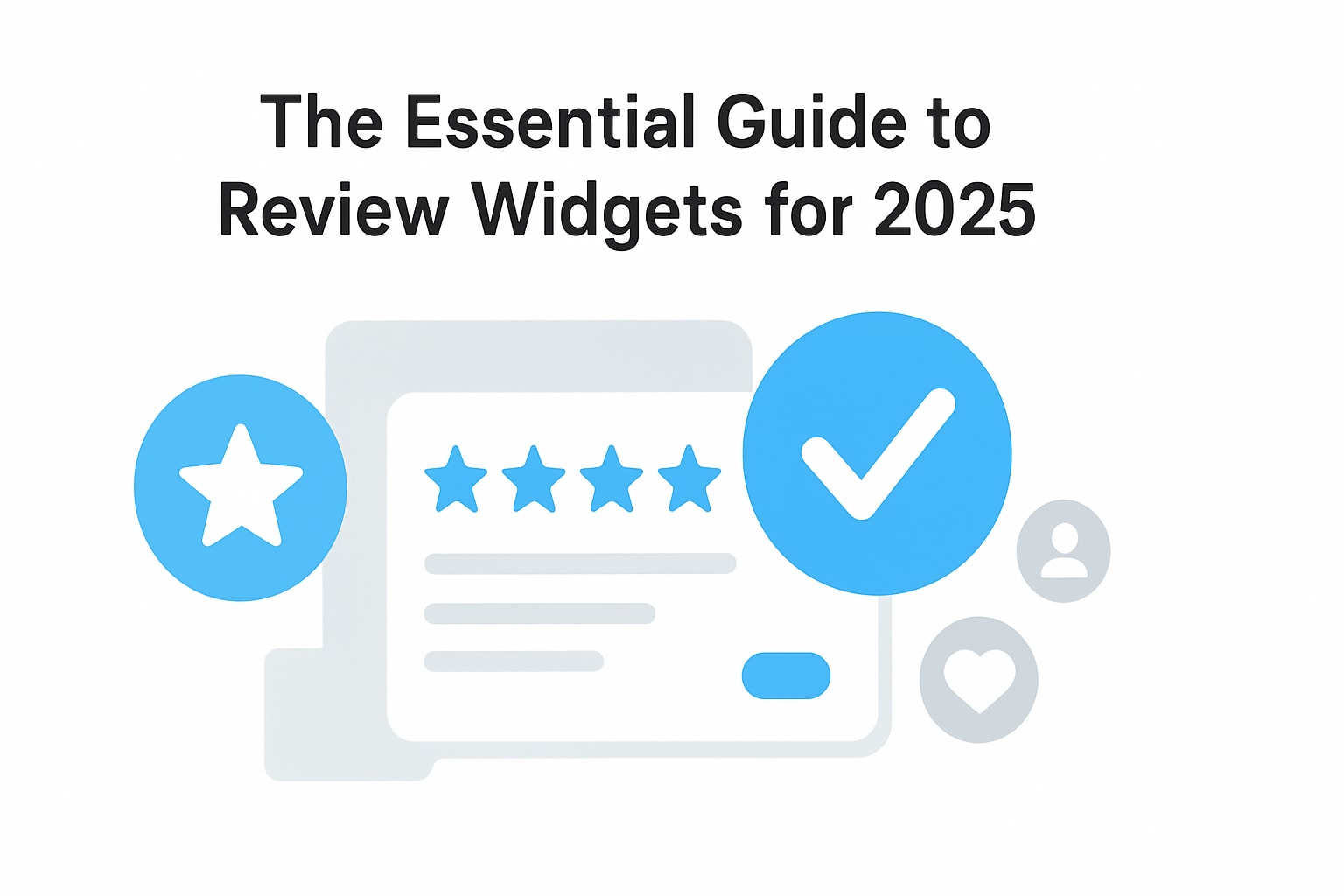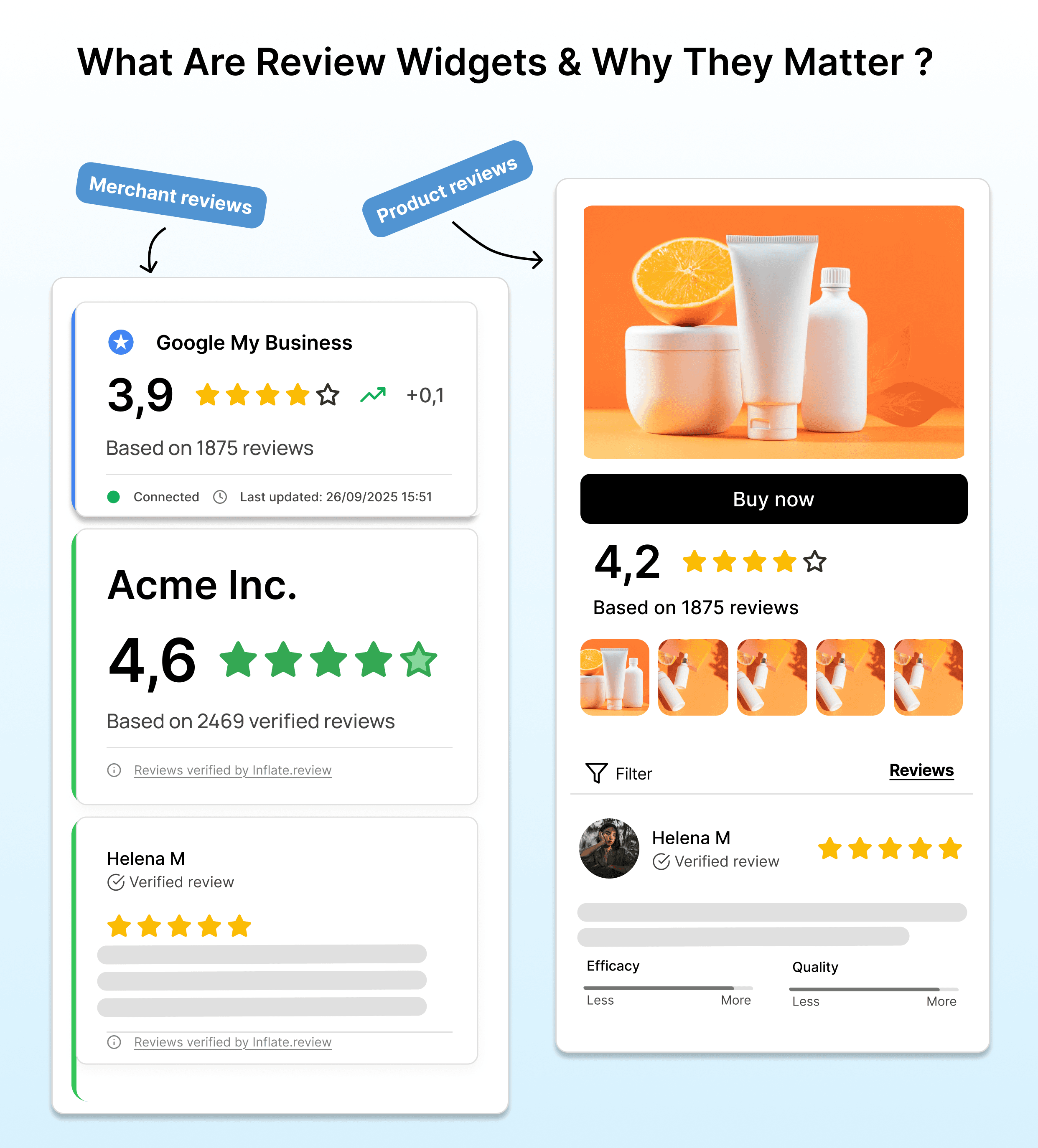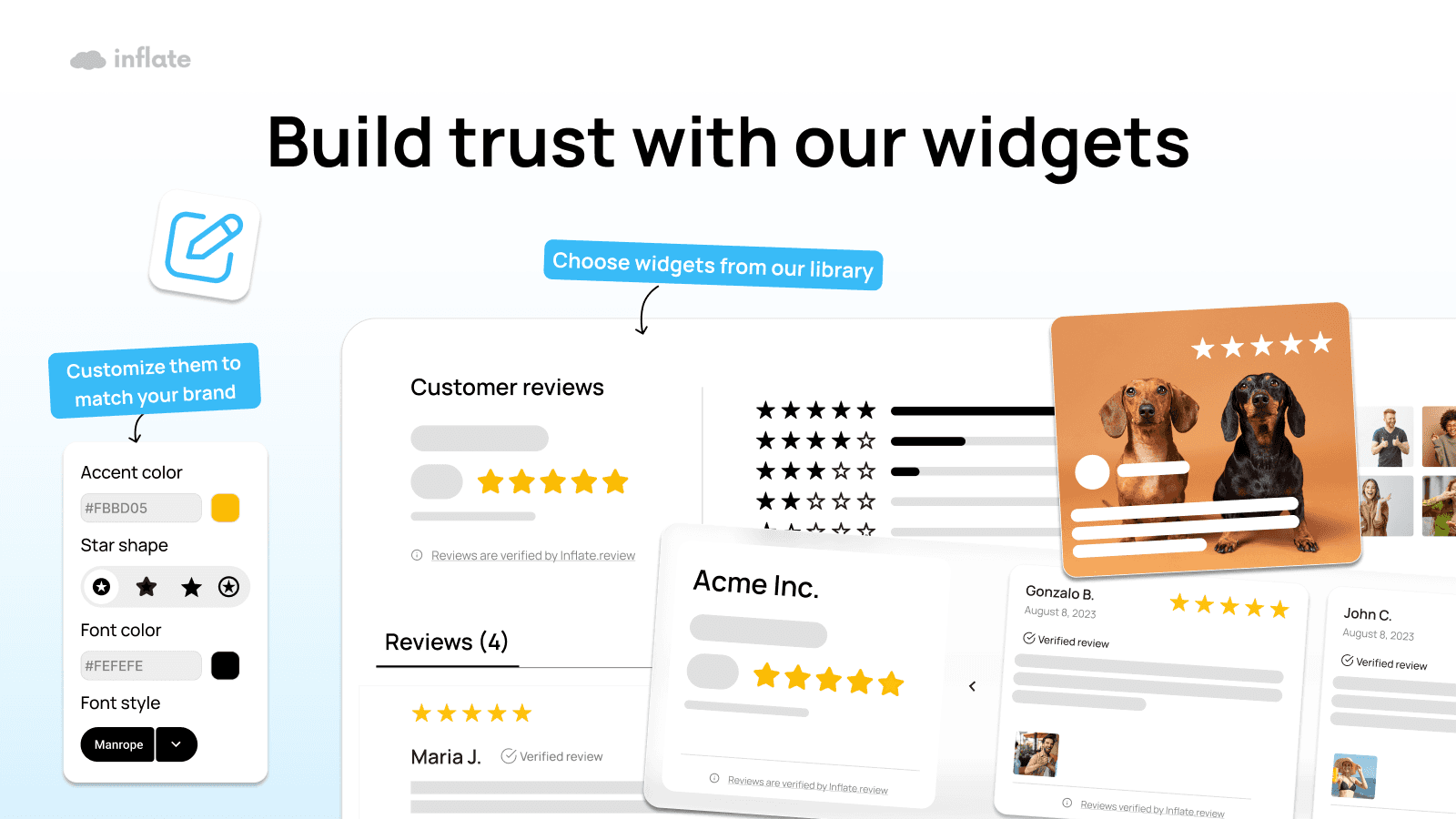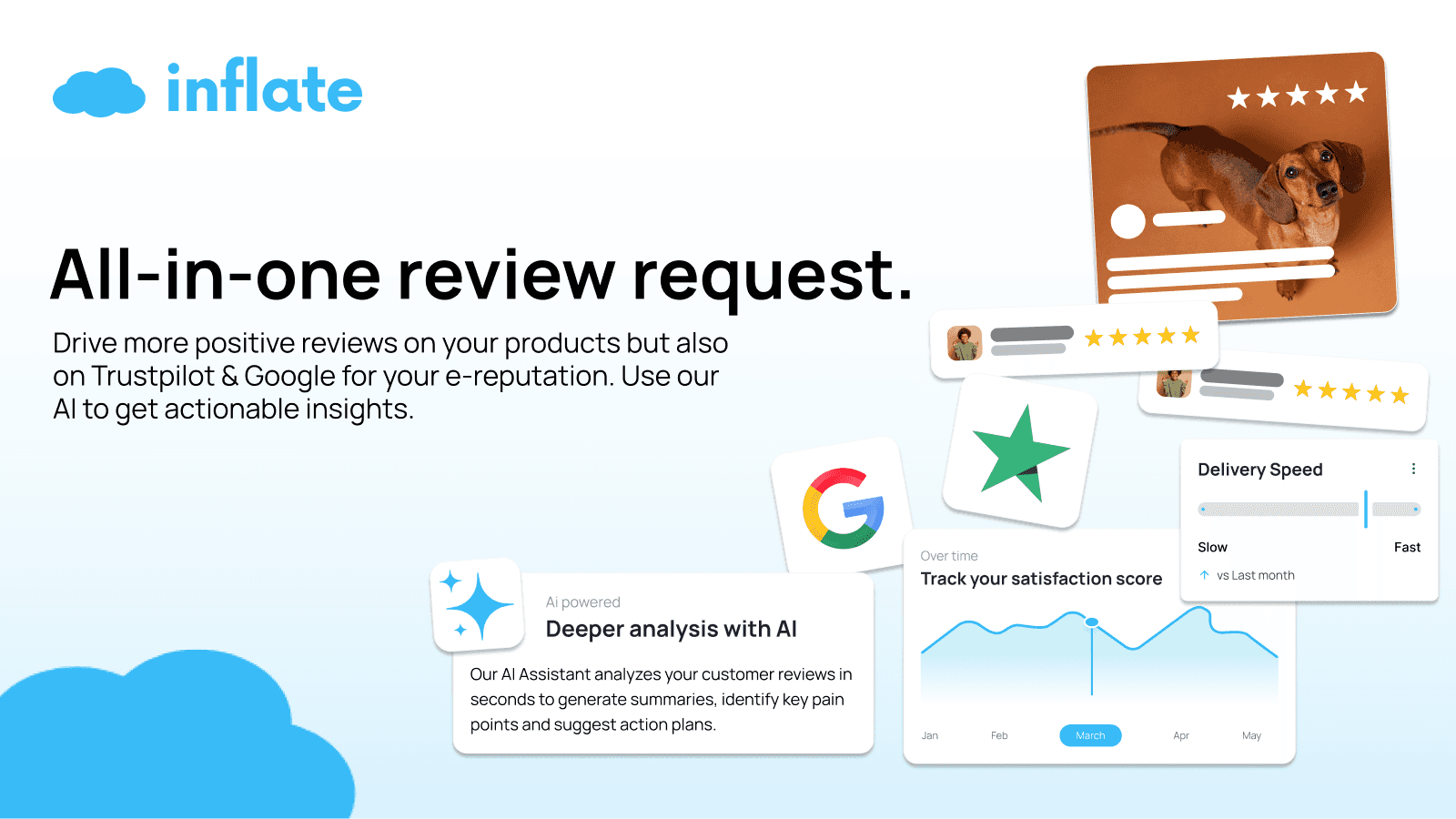The Essential Guide to Review Widgets for 2025
12 octobre 2025
In 2025, customer trust is currency—review widgets are the vault. More than 80% of buyers now research reviews before making a decision, making review widgets vital for eCommerce, SaaS, and retailers. This essential guide unpacks how to leverage review widgets for higher conversions, stronger trust, and improved SEO.
You will discover what review widgets are, why they matter, and the best strategies for design, placement, branding, automation, analytics, and more. Get ready for actionable insights that drive results and practical steps to elevate your reputation and revenue.

What are review widgets?
Review widgets are embeddable website elements that dynamically display customer reviews, ratings, and user-generated content from platforms like Google, Trustpilot, or in-house systems. They build trust, improve SEO with fresh content and star ratings, and drive higher conversions by showcasing social proof at key touchpoints.
What Are Review Widgets & Why They Matter
Review widgets are embeddable website elements that dynamically display customer reviews, ratings, and user-generated content from platforms like Google, Trustpilot, or in-house systems. They build trust, improve SEO with fresh content and star ratings, and drive higher conversions by showcasing social proof at key touchpoints.

The Evolution of Review Widgets
Review widgets have evolved from static testimonial blocks to dynamic, real-time displays. Early websites used simple text quotes, while today’s review widgets automatically sync reviews from multiple sources. This shift reflects a major change in consumer behavior. Now, over 80 percent of shoppers check reviews before making a purchase.
There are several types of review widgets: product-specific widgets, merchant-level widgets, third-party integrations (like Google or Trustpilot), and user-generated content displays. Each type offers unique ways to showcase credibility and boost engagement.
The Business Case for Review Widgets
Review widgets are proven to increase conversions, with some businesses seeing up to a 30 percent uplift. Social proof reduces buyer hesitation by showing real-time, verified feedback. These widgets also deliver SEO benefits, such as fresh content, star ratings, and eligibility for rich snippets.
By aggregating reviews from across platforms, review widgets give a single, unified view of reputation. According to Reviews as Cornerstone of eCommerce, reviews play a pivotal role in trust, SEO, and sales growth for online businesses.
Sites using review widgets consistently outperform those without, demonstrating higher conversion rates and greater customer confidence.
Key Use Cases in 2025
In 2025, review widgets are essential across many digital touchpoints. They appear on product pages, landing pages, checkout flows, and even in email signatures. Local retailers use them on contact and location pages, while SaaS companies display them on pricing and demo request pages.
Multi-brand stores benefit from aggregating reviews across products and brands, creating a holistic trust signal. No matter the industry, review widgets turn authentic feedback into a powerful asset for driving conversions, trust, and visibility.
Design & Placement: Maximizing Impact
Effective design and placement of review widgets can make the difference between a visitor bouncing or converting into a customer. Careful attention to widget style, customization, and strategic positioning is essential for building trust and maximizing sales.

Widget Formats & Customization
There are many ways to present review widgets, each offering unique benefits. Common formats include sliders that rotate through testimonials, grids that showcase volume, badges for instant trust, sidebars for persistent presence, pop-ups for attention, and buttons that link to full review pages.
Customizing review widgets for your brand is crucial. Adjust colors, fonts, and layouts so they blend seamlessly with your site's design. Responsive, mobile-first layouts ensure widgets look sharp on any device, supporting every customer journey.
For more tips on displaying review widgets, see how to showcase reviews effectively.
Strategic Placement for Conversion
Where you place review widgets directly impacts conversion rates. Placing widgets above the fold, especially on product pages, captures attention early. Heatmaps show that shoppers engage more with visible social proof.
Integrate review widgets throughout the site: homepages, category listings, product details, and checkout flows. For local businesses, consider adding widgets on contact, about, and location pages. Recent A/B testing reveals an 18 percent uplift in conversions when review widgets are positioned above product details.
Thoughtful placement helps turn browsers into buyers.
Table: Widget Type × Goal × Effort
Selecting the right review widgets format depends on your goals and resources.
Widget Type | Primary Goal | Implementation Effort |
|---|---|---|
Slider | Showcase variety | Medium |
Grid | Maximize volume | Medium |
Badge | Quick trust signal | Low |
Sidebar | Persistent visibility | Medium |
Pop-up | Capture attention | High |
Button | Click-through to reviews | Low |
By matching review widgets to your business objectives and technical capabilities, you ensure every review counts. Prioritize formats that align with your site’s user flow and brand experience for the biggest impact.
User Experience (UX) Principles for Review Widgets
User experience is the foundation of trust and conversion for review widgets. A well-designed widget does more than display ratings; it reassures visitors and streamlines their decision-making journey. In 2025, eCommerce, SaaS, and local retailers must focus on UX principles that keep users engaged and confident.

Building Trust Through UX
Building trust starts with authenticity. Review widgets should feature verified badges, real reviewer photos, and visible timestamps to signal credibility. Displaying both positive and negative feedback, with clear moderation policies, fosters transparency and prevents skepticism.
Filtering options matter. Allow users to sort reviews by recency, rating, or detail. This helps visitors find relevant social proof quickly, increasing confidence in their purchase decisions.
Accessibility is non-negotiable. Use readable fonts, strong color contrast, and alt text for images so all customers can engage with your review widgets. Avoid hiding negative feedback or using manipulative UI patterns, as these erode trust.
Interactivity and Engagement
Interactivity transforms static review widgets into conversion engines. Features like expand/collapse for lengthy reviews, sorting by rating or date, and clickable links to verified sources (such as Google or Trustpilot) empower users to dive deeper into authentic experiences.
Gamification elements—progress bars showing review counts or achievement badges—add motivation for engagement. Filtering tools ensure visitors see the most relevant content, making decision-making easier.
According to Impact of Review Widgets on Conversions, interactive and strategically placed review widgets can drive significant improvements in conversion rates, directly linking UX enhancements to ROI.
Performance & Loading
Fast-loading review widgets are essential for keeping bounce rates low and conversions high. Lazy loading ensures widgets only appear when needed, minimizing the impact on site speed.
Optimize widget code to prevent slowdowns. Even a one-second delay can reduce conversions by up to 7 percent. Regularly test widgets on mobile and desktop to maintain a seamless experience.
A retailer who improved widget loading times saw a 12 percent increase in mobile conversions. This demonstrates that performance optimization is just as vital as design or interactivity in your review widgets strategy.
Branding & Customization: Making Widgets Your Own
Branding is a crucial factor in the effectiveness of review widgets. A well-branded widget not only blends seamlessly with your site but also reinforces trust and professionalism. Consistency in visual identity across all review widgets enhances credibility, making customers more likely to engage and convert.
Aligning Widgets with Brand Identity
For eCommerce, SaaS, and retailers, aligning review widgets with your brand identity is essential. Use your brand’s color palette, preferred fonts, and logo to ensure every widget feels like a natural extension of your site. Leverage customization features such as custom CSS, advanced style controls, and layout options. Consistent design across product, merchant, and UGC widgets reinforces brand recognition.
Brand X, for example, saw a 25% boost in engagement after redesigning their review widgets to match their updated branding. When users see familiar design cues within review widgets, trust and interaction rates rise.
Showcasing User-Generated Content (UGC)
Modern review widgets go beyond text, offering dynamic displays of user-generated content. Incorporate customer photos, videos, and Q&A for richer, more authentic social proof. Robust moderation tools let you curate UGC, ensuring only relevant and brand-safe content appears.
Adapt widgets for seasonal campaigns or product launches by updating visuals and messaging. This flexibility helps keep review widgets fresh, engaging, and aligned with ongoing marketing efforts. UGC within review widgets not only builds trust but also drives higher conversion rates.
Display authentic reviews that convert—power your widgets with Inflate
Inflate empowers brands to fully customize review widgets for any eCommerce or SaaS site. With seamless integration for Shopify, WooCommerce, and major CMS platforms, you can match widgets to your exact branding. AI-powered moderation and analytics help surface the most impactful reviews, while unified collection brings product, merchant, and third-party feedback into one widget.

This all-in-one approach boosts conversions and trust by displaying real-time, verified social proof. Review widgets powered by Inflate are designed to maximize both engagement and credibility for your business.
Review Widgets & SEO: Turning Feedback into Visibility and Growth
Beyond collecting reviews, smart widgets help brands analyze, display, and leverage customer feedback to boost trust and SEO performance. With Inflate’s dashboard, discover how to centralize reviews, integrate them into your site, and track their real impact on visibility and conversion. Watch how it works in 2025.
How Review Widgets Drive SEO
Review widgets deliver fresh, user-generated content that signals relevance and trust to search engines. Google values recent reviews, high review volume, and verified feedback as key ranking factors. Sites with active review widgets often see improved local pack rankings and increased organic traffic.
Schema markup is essential. By embedding structured data in your review widgets, you enable Google to display rich snippets like star ratings and review counts directly in search results. This can lead to a 20% increase in click-through rates, as seen with SaaS landing pages.
Aggregating reviews from verified sources like Google and Trustpilot further boosts ranking power. For a deeper dive into these strategies, check out SEO and reputation management tips.
Implementing Rich Snippets
To unlock rich snippets, you’ll need to add schema markup to your review widgets’ code. This involves tagging review elements with JSON-LD or Microdata so search engines can understand and display them. Always validate your markup with Google’s Rich Results Test to avoid errors.
Common pitfalls include duplicate content, incorrect or missing schema, and using markup on pages without visible reviews. Such mistakes can trigger penalties or prevent snippets from appearing. Regularly monitor your site’s search appearance via Google Search Console to ensure your review widgets are performing as expected.
Maximizing SEO Benefits
Maximize the SEO value of your review widgets by aggregating ratings from multiple platforms. Combining Google, Trustpilot, and Facebook reviews into a unified widget amplifies trust signals and helps you stand out in crowded SERPs.
Avoid “review gating,” which means only showing positive reviews, as this violates Google’s guidelines. Instead, embrace transparency and display a balanced set of feedback. One local retailer gained prominent star ratings in organic search simply by integrating well-marked review widgets, boosting both credibility and clicks.
Automation, Sync, and Multi-Channel Review Management
Automating and synchronizing review widgets is essential for eCommerce, SaaS, and local retailers who want to maintain trust and drive conversions at scale. As customer reviews flow in from multiple sources, manual management becomes time-consuming and prone to errors. Smart automation ensures that fresh, relevant social proof is always visible where it matters most.
Automating Review Collection & Display
Modern review widgets streamline the process of gathering and displaying customer feedback. Automation triggers can send review requests via email or SMS immediately after purchase, maximizing response rates. Real-time syncing with platforms such as Google and Trustpilot keeps your content up-to-date, while AI-powered moderation filters out spam and highlights the most impactful reviews.
Scheduling regular updates ensures your review widgets always reflect the latest customer experiences. This automated approach not only saves time but also reduces the risk of stale or irrelevant content undermining your brand’s credibility.
Multi-Channel Aggregation
To maximize trust signals, review widgets must aggregate feedback from all key platforms. Combining product, merchant, and third-party reviews in a single display provides a unified view of your reputation, increasing transparency for shoppers.
Consistency across web, mobile, and email channels reinforces brand trust. For example, a multi-brand retailer can sync reviews from five or more platforms, ensuring customers always see the most recent and relevant social proof. For detailed strategies on how to manage Google reviews efficiently, explore this in-depth guide.
10-Step Checklist for Review Widget Success
Identify key pages for review widget placement
Choose the right widget format for each context
Customize design for brand alignment
Integrate schema markup for SEO
Set up automated email/SMS review requests
Connect all relevant review sources
Enable robust filtering and moderation
Test widget speed and mobile responsiveness
Monitor analytics and conversion impact
Iterate and optimize review widgets monthly
By following these steps, you’ll ensure your review widgets are always fresh, trustworthy, and conversion-focused.
Measuring Success: Metrics, Analytics, and Optimization
Success with review widgets is not just about adding stars to your site, it is about measurable growth. Tracking the right data lets eCommerce, SaaS, and local retailers prove ROI, refine strategy, and maximize impact. Here is how to translate review widgets into actionable business results.
Key Metrics to Track
To understand the performance of review widgets, monitor these essential metrics:
Conversion rate uplift before and after widget implementation
Review volume, recency, and average ratings over time
Widget engagement: clicks, scroll depth, filter usage
SEO metrics: organic traffic, click-through rate, SERP star presence
Consistent tracking helps identify trends, spot opportunities, and quickly address issues that may arise with review widgets.
Analytics Tools & Integrations
Leverage analytics for deeper insights into review widgets’ effectiveness. Most widget platforms offer built-in analytics dashboards for basic tracking. For advanced needs, integrate Google Analytics, Tag Manager, or custom event tracking to capture user interactions.
AI-powered tools can surface sentiment trends and keyword insights. For a deeper dive into how customer reviews influence SEO and conversions, explore Customer Reviews and SEO in 2025. This external resource highlights the growing role of review widgets in driving search performance.
Optimization Strategies
Optimization is ongoing. Use A/B testing to experiment with widget formats and placements. Study engagement data to refine layouts and filter options. Iterate based on what the analytics reveal.
For example, a SaaS company improved qualified leads by 18% after redesigning their review widgets using insights from analytics. Regularly review your data, adjust your approach, and keep your review widgets aligned with evolving goals and user expectations.
Review Widget Pitfalls & How to Avoid Them
Even the best review widgets can backfire if implemented with common mistakes. Understanding these pitfalls ensures your investment drives trust, conversions, and SEO gains, not setbacks.
Common Pitfalls with Review Widgets
Overloading pages with too many review widgets slows load speeds and disrupts user focus. Limit to one or two per page for clarity.
Hiding negative reviews damages trust and can result in search penalties. Always show a balanced mix to maintain credibility.
Ignoring mobile optimization drives away users. Make sure review widgets are responsive and easy to read on every device.
Failing to update or moderate content allows outdated or spammy reviews to persist, eroding confidence.
Non-compliance with Google and Trustpilot guidelines such as “review gating” or using fake reviews can lead to penalties.
Real-World Example
A retailer duplicated review content across multiple widgets and hid critical feedback. As a result, their organic search visibility dropped, and customer trust declined.
For more on building trust and compliance, see Reputation management with reviews.
How to Avoid These Issues
Regularly audit your review widgets for speed, transparency, and fresh content. Ensure every widget is mobile-optimized, compliant, and shows authentic reviews. This approach protects your reputation and keeps your conversion rates strong.
Templates & Resources: Emails, SMS, and FAQs
Unlock more conversions and build trust with expertly crafted templates for collecting reviews. Use these resources to seamlessly integrate review widgets into your eCommerce, SaaS, or retail workflows.
Email Templates for Review Requests
Boost response rates by embedding review widgets or direct links in your emails. Use these proven templates:
Thank You Email
"Thank you for your purchase! Could you share your experience? Your review helps others and builds trust. [Leave a review]"Post-purchase Follow-up
"We value your feedback. Please leave a verified review using the link below. Your insights help us improve."Win-back Campaign
"We miss you! Share your thoughts and get an exclusive perk. Review widgets make it easy to leave feedback."
Personalize each template and include a preview of your review widgets for higher engagement.
SMS Templates for Review Requests
SMS review requests are quick and effective, especially when integrated with review widgets. Try these:
"How was your purchase? Share a quick review here: [review link]"
"Your feedback matters. Leave a review and unlock exclusive perks: [review link]"
"Help us improve. Tap to review your experience: [review link]"
Keep SMS messages short, direct, and always include a clear review widgets call to action.
Frequently Asked Questions
1. How do review widgets improve conversions?
They offer instant social proof, reducing hesitation and encouraging more purchases.
2. Can I display reviews from multiple platforms?
Yes, review widgets can aggregate feedback from Google, Trustpilot, and social channels.
3. What is the best placement for review widgets?
Product pages, checkout, and email signatures drive the highest impact.
4. Are review widgets SEO-friendly?
Absolutely. They provide fresh content and can add schema markup. For more, see AI's Impact on SEO and eCommerce.
5. Are review widgets mobile responsive?
Modern widgets automatically adjust for all devices.
6. How often should I update or moderate my review widgets?
Regular updates ensure trust and compliance.
Display authentic reviews that convert—power your widgets with Inflate.
Now that you understand how review widgets can strengthen trust, boost conversions, and enhance your brand’s credibility, you might be wondering how to bring these strategies to life on your own site. With Inflate, you can streamline authentic review collection, showcase stellar feedback with customizable widgets, and leverage AI-powered insights to keep your online reputation thriving. If you’re ready to see how all these pieces fit together for your unique business, let’s take the next step together.
Book a demo
Une solution conçue pour les e-commerces
Découvrez les témoignages d’équipes qui ont simplifié la gestion de leurs avis et accompli plus avec moins.









